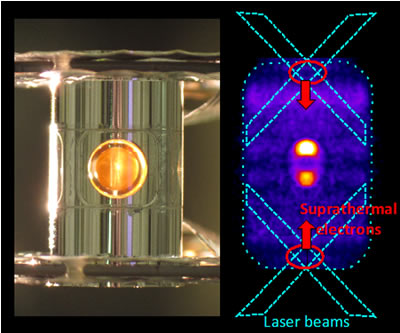Papers and Presentations - 2016
February
Controlling Early Hot Electrons in NIF Implosions
One of the factors that can limit the performance of NIF inertial confinement fusion (ICF) implosions is the presence of suprathermal, or “hot,” electrons generated by laser-plasma instabilities (LPI) in the NIF hohlraum during the early stages of the laser pulse. Hot electrons can penetrate the shell of the target capsule inside the hohlraum and preheat the fusion fuel, reducing its compression and ability to achieve ignition. The challenge would be compounded if the hot electrons were “beamed,” or focused on specific areas of the capsule, but until now there was no way to know if the beaming theory was correct.
To date, therefore, laser pulses have been carefully designed to avoid these issues, drawing on the results of extensive experimental data obtained in collaboration with colleagues from the Laboratory for Laser Energetics (LLE) at the University of Rochester on the OMEGA laser prior to the National Ignition Campaign on NIF.  An ICF target showing a surrogate bismuth capsule inside the hohlraum (left) and an illustration of target x-ray emission caused by LPI suprathermal electrons (approximate source locations shown by red circles) demonstrating electron beaming onto the capsule. Although hot-electron production has been routinely monitored on a shot-to-shot basis on NIF by measuring the characteristic x-rays emitted by these electrons, these measurements could not tell if the electrons were beaming at the capsule. If they were, researchers could have been drastically underestimating their impact on the implosion.
An ICF target showing a surrogate bismuth capsule inside the hohlraum (left) and an illustration of target x-ray emission caused by LPI suprathermal electrons (approximate source locations shown by red circles) demonstrating electron beaming onto the capsule. Although hot-electron production has been routinely monitored on a shot-to-shot basis on NIF by measuring the characteristic x-rays emitted by these electrons, these measurements could not tell if the electrons were beaming at the capsule. If they were, researchers could have been drastically underestimating their impact on the implosion.
In a Physical Review Letters paper published on Feb. 17, LLNL researchers reported on experiments and simulations revealing for the first time the directionality of the hot electrons and the extent of capsule preheat they can cause. By imaging the hard x-rays caused by the impact of the suprathermal electrons, they were able to quantify the location and energy of electrons deposited in the capsule.
Hot electrons are generated in the first stage, or “picket,” of the laser pulse as the laser beams blow through the hohlraum’s laser entrance hole (LEH) plastic windows that retain the hohlraum gas fill. The new experimental data, combined with Monte Carlo calculations, indicate that for most experiments the hot electrons are emitted nearly isotropically (equal amounts in all directions) from the LEH.
But the new technique revealed that under certain circumstances, a significant fraction of the suprathermal electrons can be emitted in a collimated beam directly toward the capsule poles. In these cases, their local energy deposition can reach more than 100 times more than when electrons are emitted isotropically. Averaged over the entire capsule, this would lead to a factor of 20 more heating in a fuel capsule than would have been interpreted assuming isotropic electrons.
The researchers also were able to quantify the spatial uniformity of energy deposition over the capsule using the new technique. “Our results…show that the electron energy deposition in the DT (deuterium-tritium) fuel is spatially nonuniform at the capsule, giving more preheat at its poles than at the equator, by a factor of about 2 in cases of isotropic emissions and up to a factor of about 30 in cases of beaming,” they said.
The technique employed to date to control the amount of early-time hot electrons consisted of adjusting the power and duration of the low-intensity prepulse, or “toe,” of the laser pulse as well as the level of the ensuing higher-intensity picket. The study confirmed that this technique has kept hot electrons below levels of concern in most ICF implosions. In the future this technique will help ensure that new ICF designs are steered away from too much early-time hot-electron preheat.
Lead author Eduard Dewald was joined on the paper by LLNL colleagues Fred Hartemann, Pierre Michel, Jose Milovich, Arthur Pak, Nino Landen, Laurent Divol, Harry Robey, Omar Hurricane, Tilo Döppner, Félicie Albert, Benjamin Bachmann, Nathan Meezan, Andy MacKinnon, Debbie Callahan, and John Edwards, and by Matthias Hohenberger of LLE.



